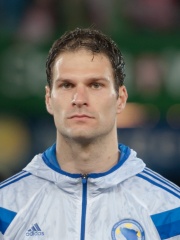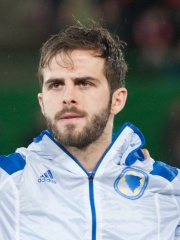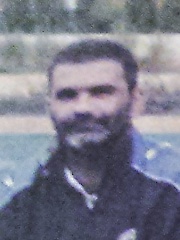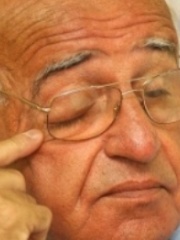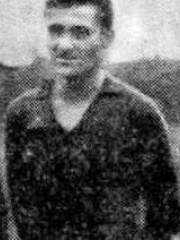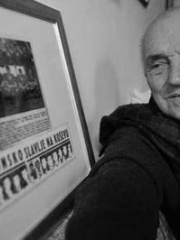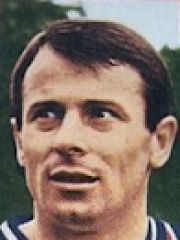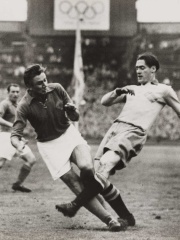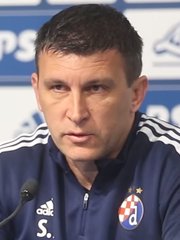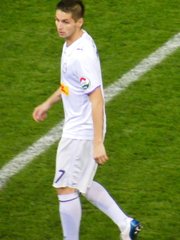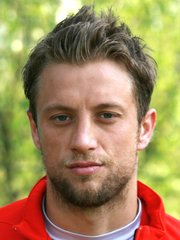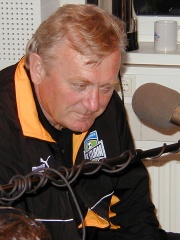
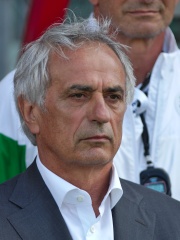
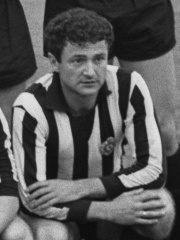
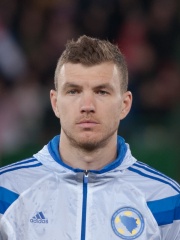

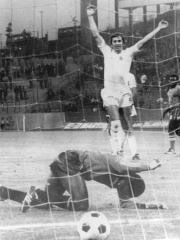
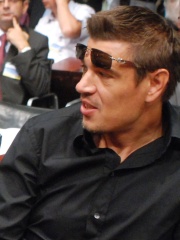
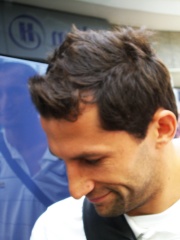
The Most Famous
SOCCER PLAYERS from Bosnia and Herzegovina
This page contains a list of the greatest Bosnian, Herzegovinian Soccer Players. The pantheon dataset contains 21,273 Soccer Players, 141 of which were born in Bosnia and Herzegovina. This makes Bosnia and Herzegovina the birth place of the 35th most number of Soccer Players behind Ukraine, and Cameroon.
Top 10
The following people are considered by Pantheon to be the top 10 most legendary Bosnian, Herzegovinian Soccer Players of all time. This list of famous Bosnian, Herzegovinian Soccer Players is sorted by HPI (Historical Popularity Index), a metric that aggregates information on a biography's online popularity. Visit the rankings page to view the entire list of Bosnian, Herzegovinian Soccer Players.

1. Ivica Osim (1941 - 2022)
With an HPI of 69.45, Ivica Osim is the most famous Bosnian, Herzegovinian Soccer Player. His biography has been translated into 50 different languages on wikipedia.
Ivan Osim (6 May 1941 – 1 May 2022), best known as Ivica Osim, was a Bosnian professional footballer and football manager. Widely regarded as one of the greatest Bosnian football managers of all time, he is also seen as one of the most influential football managers in the former Yugoslavia. As a player, Osim was in the Yugoslavia national team and played at the 1964 Summer Olympics. He also represented Yugoslavia at UEFA Euro 1968, where he won a silver medal and was voted into the Team of the Tournament. As a manager, Osim won a bronze medal with Yugoslavia at the 1984 Summer Olympics as an assistant, and reached the quarter-finals of the 1990 FIFA World Cup as head coach of the Yugoslavia national team. He also reached the 1984–85 UEFA Cup semi-finals as manager of his hometown club Željezničar. Osim was head coach of the Japan national team, before suffering a stroke in November 2007 and subsequently leaving the post. In April 2011, FIFA announced that he had become president of the interim committee to run the Football Association of Bosnia and Herzegovina after the country was suspended from all international competitions. He served until December 2012. Osim died in May 2022, after years of health issues following his stroke.

2. Vahid Halilhodžić (b. 1952)
With an HPI of 69.23, Vahid Halilhodžić is the 2nd most famous Bosnian, Herzegovinian Soccer Player. His biography has been translated into 48 different languages.
Vahid Halilhodžić (Bosnian pronunciation: [ʋȃ:xid xǎlilxodʒitɕ]; born 15 May 1952) is a Bosnian professional football manager and former player. He is regarded as one of the most controversially successful Bosnian football managers, due to his successful tenure in coaching various national teams yet having problematic relations with his teams and players due to different approaches. Regarded as one of the best Yugoslav players, Halilhodžić had successful playing spells with Velež Mostar and French clubs Nantes and Paris Saint-Germain before retiring in 1987. During that time, he earned 15 full international caps for Yugoslavia and was part of national squads who won the 1978 European Under-21 Championship and played at the 1982 FIFA World Cup. He was top scorer of the French league in 1983 and 1985. In the early 1990s, Halilhodžić turned to coaching and, after a short stint as a sporting director at Velež, permanently moved to France in 1993 after fleeing war-torn Bosnia with his family. Since then, he managed a number of teams in French-speaking countries and his achievements include winning the 1997 CAF Champions League with Moroccan side Raja Casablanca, leading French side Lille from second level to third place in Ligue 1 in less than three years, winning the 2003–04 Coupe de France with Paris Saint-Germain, and winning the Croatian league in 2011 with Dinamo Zagreb. Halilhodžić also qualified for the 2010 World Cup with Ivory Coast (although he was sacked only months before the final tournament) and the 2014 World Cup with Algeria, with whom he reached the round of 16, Algeria's best result in history. Later, he qualified for the 2018 World Cup with Japan, but again was fired just prior to the tournament. After a short stint with Nantes in 2018, where he helped avoid relegation to Ligue 2, Halilhodžić became head coach of the Morocco national team, whom he qualified for the 2022 World Cup. Like with Ivory Coast and Japan, he was sacked by the Royal Moroccan Football Federation in August 2022, after Morocco's poor performance at the 2021 Africa Cup of Nations and his fallout with star player Hakim Ziyech.

3. Milan Galić (1938 - 2014)
With an HPI of 65.61, Milan Galić is the 3rd most famous Bosnian, Herzegovinian Soccer Player. His biography has been translated into 32 different languages.
Milan Galić (Serbian Cyrillic: Милан Галић, pronounced [mǐlaŋ ɡǎːlitɕ]; 8 March 1938 – 13 September 2014) was a Yugoslav and Serbian professional footballer who played as a striker. He was part of the Yugoslav squad that won gold at the 1960 Summer Olympics. During his active career, Galić played for four clubs, namely Proleter Zrenjanin, Partizan, Standard Liège and Reims. He also represented Yugoslavia internationally, earning 51 caps and scoring 37 goals, being the second-highest scorer in the history of the national team, only behind Stjepan Bobek with 38. After finishing his playing career, Galić was employed at the Football Association of Yugoslavia.

4. Edin Džeko (b. 1986)
With an HPI of 63.24, Edin Džeko is the 4th most famous Bosnian, Herzegovinian Soccer Player. His biography has been translated into 63 different languages.
Edin Džeko (Bosnian pronunciation: [ědin dʒêːko]; born 17 March 1986) is a Bosnian professional footballer who plays as a striker for Serie A club Fiorentina and captains the Bosnia and Herzegovina national team. He is the all-time top goalscorer and most capped player of the Bosnian national team. Džeko was named Bosnian Footballer of the Year for three years in a row. He has been nicknamed "the Bosnian Diamond" (Bosnian: Bosanski dijamant) or simply "Diamond" (Dijamant) by football fans and journalists in Bosnia and Herzegovina. Prior to joining Fiorentina, he played for Manchester City, Roma, Inter Milan and Fenerbahçe, but he made a name for himself while playing for German club VfL Wolfsburg, with whom he won the Bundesliga in the 2008–09 season. He was the second-highest goalscorer with 26 goals. In the 2009–10 season, Džeko was the top scorer with 22 goals. He also registered ten assists in both seasons. During the 2011–12 Premier League season, Džeko scored four goals in one game for Manchester City against Tottenham Hotspur at White Hart Lane. On the final day of that season, he scored an equaliser against Queens Park Rangers in the 92nd minute, before Sergio Agüero won it for City with seconds to go, ensuring the team won a league title for the first time in 44 years. Džeko finished as the top scorer of Serie A in the 2016–17 season, scoring 29 goals for Roma. On 3 March 2018, he scored his 50th league goal for the club, thus becoming the first player ever to score 50 goals in three of Europe's top five major leagues. A former youth international for Bosnia and Herzegovina, Džeko made his senior international debut in 2007, earning over 140 caps and scoring 72 goals since. Džeko became the highest Bosnia and Herzegovina goalscorer of all time on 7 September 2012 in a game against Liechtenstein, scoring a hat-trick to surpass Zvjezdan Misimović and Elvir Bolić. On 11 September 2018, in a game against Austria, he played his 95th game for Bosnia and Herzegovina and surpassed Emir Spahić to become the country's most-capped player. His ten goals in the qualifying campaign helped his national team qualify for its first international tournament, the 2014 FIFA World Cup.

5. Branko Stanković (1921 - 2002)
With an HPI of 62.92, Branko Stanković is the 5th most famous Bosnian, Herzegovinian Soccer Player. His biography has been translated into 25 different languages.
Branko "Stane" Stanković (Serbian Cyrillic: Бранко "Стане" Станковић, pronounced [brâːŋko stǎːŋkoʋitɕ]; 31 October 1921 – 20 February 2002) was a Bosnian Serb footballer and manager, from Sarajevo.

6. Asim Ferhatović (1933 - 1987)
With an HPI of 60.94, Asim Ferhatović is the 6th most famous Bosnian, Herzegovinian Soccer Player. His biography has been translated into 16 different languages.
Asim Ferhatović "Hase" (pronounced [ǎsim ferxǎːtoʋitɕ xâ:se]; 24 January 1933 – 23 January 1987) was a Bosnian professional footballer who played as a striker. He started his football career in 1948 with hometown club FK Sarajevo, for whom he made his first-team debut in 1952. Ferhatović remained with the club until his retirement in 1967, although he represented Fenerbahçe in the 1962–63 Turkish league season. He won a solitary cap for the Yugoslavia national team in 1961.

7. Josip Katalinski (1948 - 2011)
With an HPI of 60.93, Josip Katalinski is the 7th most famous Bosnian, Herzegovinian Soccer Player. Her biography has been translated into 21 different languages.
Josip Katalinski (12 May 1948 – 9 June 2011) was a Bosnian professional football manager and player.

8. Savo Milošević (b. 1973)
With an HPI of 60.60, Savo Milošević is the 8th most famous Bosnian, Herzegovinian Soccer Player. His biography has been translated into 45 different languages.
Savo Milošević (Serbian Cyrillic: Саво Милошевић, pronounced [sǎːʋo milǒːʃeʋitɕ]; born 2 September 1973) is a Serbian professional football manager and former player. A former forward, he signed for English club Aston Villa after making a name for himself at Partizan. He would go on to spend the vast majority of his career in Spain, where he amassed La Liga totals of 91 goals in 241 games for Zaragoza, Espanyol, Celta and Osasuna. Over the course of his 16-year professional career, Milošević played for eight clubs and scored over 220 goals in nearly 600 official appearances. At the international level, Milošević played for the national team of FR Yugoslavia (later renamed Serbia and Montenegro) and Serbia, making over 100 caps for both teams combined. He appeared in two World Cups and one European Championship, at which he earned the Golden Boot at Euro 2000.

9. Hasan Salihamidžić (b. 1977)
With an HPI of 60.05, Hasan Salihamidžić is the 9th most famous Bosnian, Herzegovinian Soccer Player. His biography has been translated into 44 different languages.
Hasan Salihamidžić (Bosnian pronunciation: [xǎsan salixǎmidʒitɕ]; born 1 January 1977), nicknamed Brazzo (Bosnian: Braco, pronounced [brǎːtso], "Little Bro"), is a Bosnian former professional footballer who last served as sporting director of Bundesliga club Bayern Munich. After starting his club career with German side Hamburger SV, he made a name for himself while playing for Bayern Munich for nine seasons with whom he won the Bundesliga title six times, DFB-Pokal title four times, the 2000–01 UEFA Champions League and the 2001 Intercontinental Cup. He also played for Italian club Juventus for four seasons. During his career, Salihamidžić usually played as a right midfielder or full back. He was a quick and energetic player with an extremely high work rate. He was also gifted with good crossing and passing abilities, which allowed him to create chances for his teammates. He earned 42 caps and scored six goals for the Bosnia and Herzegovina national team. He is regarded by many as one of the most successful Bosnian football players. Following the end of his one-year contract with VfL Wolfsburg in 2012, Salihamidžić retired from professional football. He then worked for Sky Deutschland, RTL and ZDF, before re-joining Bayern Munich as sporting director in 2017.

10. Goran Jurić (b. 1963)
With an HPI of 59.52, Goran Jurić is the 10th most famous Bosnian, Herzegovinian Soccer Player. His biography has been translated into 47 different languages.
Goran "Goca" Jurić (born 5 February 1963) is a Croatian former professional footballer who played as a defender. During his career, he played for Velež Mostar, Red Star Belgrade, Celta Vigo, Croatia Zagreb, Yokohama F. Marinos, and NK Zagreb. He earned 4 caps for the Yugoslavia national football team in 1988, and 16 caps for the Croatia national football team.
People
Pantheon has 141 people classified as Bosnian, Herzegovinian soccer players born between 1917 and 2003. Of these 141, 127 (90.07%) of them are still alive today. The most famous living Bosnian, Herzegovinian soccer players include Vahid Halilhodžić, Edin Džeko, and Savo Milošević. The most famous deceased Bosnian, Herzegovinian soccer players include Ivica Osim, Milan Galić, and Branko Stanković. As of April 2024, 14 new Bosnian, Herzegovinian soccer players have been added to Pantheon including Sejad Halilović, Sergej Jakirović, and Vlado Čapljić.
Living Bosnian, Herzegovinian Soccer Players
Go to all RankingsVahid Halilhodžić
1952 - Present
HPI: 69.23
Edin Džeko
1986 - Present
HPI: 63.24
Savo Milošević
1973 - Present
HPI: 60.60
Hasan Salihamidžić
1977 - Present
HPI: 60.05
Goran Jurić
1963 - Present
HPI: 59.52
Zlatko Vujović
1958 - Present
HPI: 59.06
Asmir Begović
1987 - Present
HPI: 58.98
Enver Marić
1948 - Present
HPI: 58.83
Miralem Pjanić
1990 - Present
HPI: 58.54
Faruk Hadžibegić
1957 - Present
HPI: 58.38
Blaž Slišković
1959 - Present
HPI: 58.06
Tomislav Knez
1938 - Present
HPI: 57.90
Deceased Bosnian, Herzegovinian Soccer Players
Go to all RankingsIvica Osim
1941 - 2022
HPI: 69.45
Milan Galić
1938 - 2014
HPI: 65.61
Branko Stanković
1921 - 2002
HPI: 62.92
Asim Ferhatović
1933 - 1987
HPI: 60.94
Josip Katalinski
1948 - 2011
HPI: 60.93
Vlatko Marković
1937 - 2013
HPI: 59.38
Andrija Anković
1937 - 1980
HPI: 59.21
Ibrahim Biogradlić
1931 - 2015
HPI: 58.75
Ilija Pantelić
1942 - 2014
HPI: 57.72
Miroslav Brozović
1917 - 2006
HPI: 57.21
Muhamed Mujić
1933 - 2016
HPI: 56.91
Velimir Sombolac
1939 - 2016
HPI: 56.23
Newly Added Bosnian, Herzegovinian Soccer Players (2025)
Go to all RankingsSejad Halilović
1969 - Present
HPI: 47.51
Sergej Jakirović
1976 - Present
HPI: 45.24
Vlado Čapljić
1962 - Present
HPI: 43.69
Mirsad Hibić
1973 - Present
HPI: 42.19
Petar Sučić
2003 - Present
HPI: 40.94
Mario Božić
1983 - 2023
HPI: 39.14
Ivan Krstanović
1983 - Present
HPI: 36.60
Adnan Mravac
1982 - Present
HPI: 36.48
Haris Handžić
1990 - Present
HPI: 34.86
Gordan Bunoza
1988 - Present
HPI: 32.33
Darko Todorović
1997 - Present
HPI: 32.25
Mateo Sušić
1990 - Present
HPI: 31.35
Overlapping Lives
Which Soccer Players were alive at the same time? This visualization shows the lifespans of the 13 most globally memorable Soccer Players since 1700.


